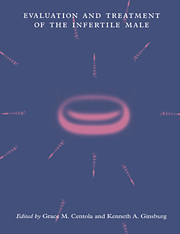Book contents
- Frontmatter
- Contents
- Preface
- List of contributors
- 1 Andrology
- 2 Sperm–egg interaction
- 3 Routine semen analysis
- 4 Computer-aided sperm analysis: a critical review
- 5 Antisperm antibodies: diagnosis and treatment
- 6 The sperm penetration assay
- 7 Intrauterine insemination for male factor
- 8 Processing human semen for insemination: comparison of methods
- 9 New assays for evaluating sperm function
- 10 Assisted reproductive technology for male factor infertility
- 11 Microinjection techniques for male infertility
- 12 Therapeutic donor insemination: screening, indications and technique
- 13 Endocrine assessment and hormone treatment of the infertile male
- 14 The urologic evaluation of the infertile male
- 15 Azoospermia: the diagnosis and treatment
- 16 White blood cells in semen and their impact on fertility
- 17 Psychological aspects of male infertility: lifting the shroud of shame
- 18 Evaluation of the female partner
- Index
17 - Psychological aspects of male infertility: lifting the shroud of shame
Published online by Cambridge University Press: 16 September 2009
- Frontmatter
- Contents
- Preface
- List of contributors
- 1 Andrology
- 2 Sperm–egg interaction
- 3 Routine semen analysis
- 4 Computer-aided sperm analysis: a critical review
- 5 Antisperm antibodies: diagnosis and treatment
- 6 The sperm penetration assay
- 7 Intrauterine insemination for male factor
- 8 Processing human semen for insemination: comparison of methods
- 9 New assays for evaluating sperm function
- 10 Assisted reproductive technology for male factor infertility
- 11 Microinjection techniques for male infertility
- 12 Therapeutic donor insemination: screening, indications and technique
- 13 Endocrine assessment and hormone treatment of the infertile male
- 14 The urologic evaluation of the infertile male
- 15 Azoospermia: the diagnosis and treatment
- 16 White blood cells in semen and their impact on fertility
- 17 Psychological aspects of male infertility: lifting the shroud of shame
- 18 Evaluation of the female partner
- Index
Summary
Introduction
Infertility has predominantly been viewed as a female infliction (Menning, 1988). In some cultures, when a couple is unable to conceive the man may be granted a divorce so he can remarry, on the basis of the automatic assumption of female factor infertility (Greil, 1991). The notion that the problem might originate in man is not even entertained. In our own culture, most infertility research has focused on the female reproductive system, resulting in a greater array of diagnostic and treatment alternatives for women than for men (Office of Technology Assessment, 1988). Yet, approximately 35% of infertile couples have trouble conceiving due to male factor infertility and another 20% due to combined male and female factor problems (Menning, 1988). In this chapter we will first address the societal context of male infertility and masculinity, then discuss gender and couple patterns of distress and treatment, how health care professionals can reduce the shame response, secrecy in donor insemination, and male sexual dysfunction.
The male response to infertility
Historically and across cultures, there has been difficulty in accepting the existence of male infertility. The individual and collective denial of male factor infertility may occur for a variety of reasons. Since it takes two to create a pregnancy, the assumption of who is defective may be guided by which gender is easier to label as abnormal. Historically, women have been viewed as being less valuable, less intelligent, and less capable in our male-dominated society (Tavris, 1992).
- Type
- Chapter
- Information
- Evaluation and Treatment of the Infertile Male , pp. 277 - 296Publisher: Cambridge University PressPrint publication year: 1996

